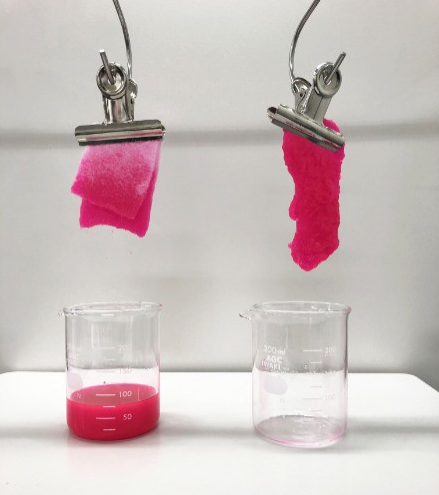Recent Developments in Nanofibers
Application Areas
Medical
Cell scaffolds, wound healing, wound dressings, artificial blood vessels, Drug Delivery Systems (DDS), bone regeneration, artificial corneas, nerve regeneration
Food
Preservatives
Cosmetics
Skincare
Energy
Batteries, separators
Environment
Filtration filters, adsorbents, sensors
Functionality Enhancement
Specialized medical care
Health care
The global regenerative medicine market size is estimated at 38.65 billion USD in 2024, with a forecast to reach 115.75 billion USD by 2029, growing at a CAGR of 24.53% during the forecast period (2024 to 2029).
Ashwini Wali and colleagues have developed antimicrobial wound dressings by encapsulating silver nanoparticles in nanofibers made of materials that are biodegradable and highly biocompatible. In experiments using rats, high wound closure properties were confirmed.

Figure 1. Overview of Wound Dressing Nanofibers( Quoted from “Silver nanoparticles in electrospun ethyl hydroxy ethyl cellulose-PVA Nanofiber: Synthesis, characterization and wound dressing applications.”)
PCL (Polycaprolactone) is highly biocompatible and commonly used in medical applications. Yue Hu and colleagues have incorporated quercetin into PCL to create nanofiber membranes, which promote periodontal tissue regeneration. Experiments in rats have shown favorable results in periodontal bone regeneration, raising hopes for its application in the treatment of periodontal disease.

Figure 2. Overview of Periodontal Bone Regeneration Nanofibers( Quoted from “A multifunctional quercetin/polycaprolactone electrospun fibrous membrane for periodontal bone regeneration.”)
In addition to the mentioned applications, nanofibers are applied in various fields within medicine, including as cell scaffolds, artificial blood vessels, and Drug Delivery Systems (DDS), showcasing their versatility.
Environment
Nanofibers are also applied in the environmental field, for instance in filtration filters and adsorbents.
Addressing environmental pollution issues, especially the effective removal of contaminants from industrial wastewater, is crucial. Hind M. Saleh and colleagues have focused on the removal of methylene blue, an organic dye widely used across industries. By incorporating chitosan into PCL to create nanofiber membranes, interactions between the polymers have significantly enhanced adsorption capacity. The use of biodegradable polymers promises an environmentally friendly and effective solution for adsorption materials.

Figure 3. Oil Absorbent Made of Nanofibers(Quoted from the M-Tech Corporation website)
Energy
Nanofibers are applied in the energy sector as well, in batteries and separators, among other applications. Mr. Ping and his team have created standalone electrodes that do not require conductive carbon or binders, aiming to address the challenges of lithium-sulfur batteries. The nanofibers, produced through electrospinning, have nanoparticles uniformly embedded within them, enhancing electrical conductivity. Furthermore, these nanofibers possess excellent mechanical properties even when bent, making them suitable for flexible battery applications due to their durable and adaptable electrode construction.

Figure 4. Overview of Standalone Electrode Using Nanofibers( Quoted from “Efficient and Homogenous Precipitation of Sulfur Within a 3D Electrospun Heterocatalytic Rutile/Anatase TiO2-x Framework in Lithium–Sulfur Batteries.”)
Nanofibers are applied in a wide range of fields and applications beyond those mentioned above, with numerous universities and companies conducting research in this area. Thus, further development of the nanofiber industry is expected.
References
- Regenerative Medicine Market Size and Market Share Analysis – Growth Trends and Forecast (2024 to 2029)
(https://www.mordorintelligence.com/ja/industry-reports/global-regenerative-medicines-market-industry) - Ashwini Wali et al. (2024) Silver nanoparticles in electrospun ethyl hydroxy ethyl cellulose-PVA Nanofiber: Synthesis, characterization and wound dressing applications.
Elsevier(https://www.sciencedirect.com/science/article/pii/S2666893924000574) - Yue Hu et al. (2024) A multifunctional quercetin/polycaprolactone electrospun fibrous membrane for periodontal bone regeneration.
Elsevier(https://pubs.acs.org/doi/full/10.1021/acsomega.3c07523) - Hind M. Saleh et al. (2024) Design, Preparation, and Characterization of Polycaprolactone–Chitosan Nanofibers via Electrospinning Techniques for Efficient Methylene Blue Removal from Aqueous Solutions.
MDPI(https://www.mdpi.com/2504-477X/8/2/68) - Ping Feng et al. (2024) Efficient and Homogenous Precipitation of Sulfur Within a 3D Electrospun Heterocatalytic Rutile/Anatase TiO2-x Framework in Lithium–Sulfur Batteries. SPRINGER
LINK(https://link.springer.com/article/10.1007/s42765-024-00380-1)
